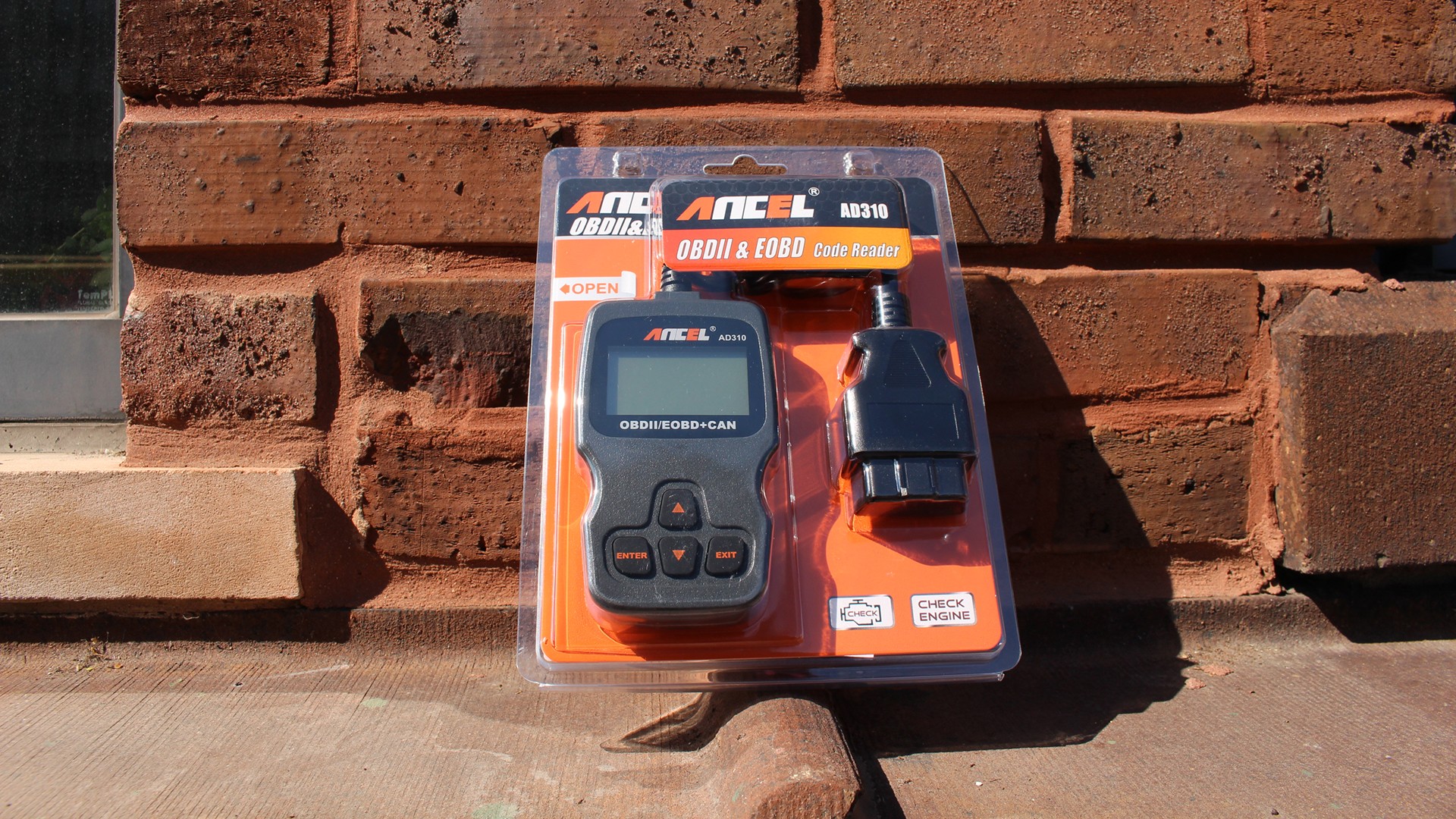The check engine light, that little beacon on your dashboard, can be a source of dread or curiosity, depending on your relationship with car maintenance. For many, it signals an expensive trip to the mechanic. But for DIY enthusiasts, it’s a puzzle to be solved. OBD2 scanners are the key to deciphering this automotive enigma, offering a peek into your car’s health.
Among the myriad of OBD2 scanners available, the Ancel AD310 stands out as an entry-level option, promising to demystify those engine codes without breaking the bank. But with so many choices, is this budget scanner the right tool for you? In this comprehensive review, we’ll delve into the Ancel AD310 OBD2 scanner, exploring its features, benefits, and drawbacks to help you decide if it deserves a spot in your garage.
Ancel AD310 OBD2 Scanner Unboxing: Simple, no-frills packaging for a budget-friendly tool.
Ancel AD310: Key Specifications
Before we dive deeper, let’s take a look at the technical specifications of the Ancel AD310:
- Weight: 9.6 ounces
- Dimensions: Approximately 5 x 3 inches
- Display: 2.25-inch LCD, black and white
- Included: AD310 scanner, user manual
- Case: Not included
- Cable Length: 31-inch cord
- Ports: Mini-B USB
- PC Connectivity: Mini-B USB (cable not included)
- Smartphone Compatibility: No
- Vehicle Compatibility: OBDII compliant vehicles (most post-1996 US, post-2000 European, and Asian cars)
- Live Data: Yes
First Impressions: Affordable and Functional
The Ancel AD310 arrives in simple, easy-to-open packaging. It’s immediately apparent that this is a no-frills device. The plastic casing feels light and budget-oriented, as expected for its price point. While it might not win any design awards, the textured body provides a decent grip, minimizing slippage. The cord, however, feels surprisingly robust and durable, suggesting it will withstand regular use.
For those accustomed to color screens and sleek interfaces, the AD310’s black and white LCD screen might seem a bit dated. However, the display is clear and readable, even in bright garage lighting. The button layout is straightforward – up, down, enter, and exit – making navigation intuitive even for first-time OBD2 scanner users.
Pros at a Glance:
- Budget-Friendly: Extremely affordable OBD2 scanner.
- User-Friendly Interface: Simple and intuitive menu navigation.
- Code Definitions: Displays code definitions directly on screen.
- Live Data Stream: Offers real-time vehicle data monitoring.
- Quick Connection: Establishes a connection and reads codes rapidly.
- Sturdy Cable: Durable and well-insulated OBD2 connector cable.
Cons at a Glance:
- Basic Display: Outdated black and white LCD screen.
- Plastic Build: Feels lightweight and potentially less durable.
- Slow Scrolling: Menu scrolling can be slightly sluggish.
- Mini-B USB Port: Uses an older, less common USB port, and cable not included.
- Limited Advanced Features: Does not support ABS, SRS, or transmission codes.
Ancel AD310 OBD2 Scanner Screen: Basic but functional LCD display showing diagnostic trouble codes.
Getting Started with the Ancel AD310
Using the Ancel AD310 is remarkably straightforward. The process is designed to be user-friendly, even for those unfamiliar with OBD2 scanners.
- Connect: With the ignition off, locate the OBD2 port in your vehicle (typically under the dashboard on the driver’s side) and plug in the AD310.
- Power On: Turn the ignition to the “on” position (do not start the engine unless instructed by the scanner for specific functions).
- Navigate Menu: The AD310 will power on automatically and prompt you to “Press any key to continue.”
- Select Diagnostics: Once in the main menu, choose “Diagnostics.”
- Scanning: The scanner will automatically link to your vehicle’s computer and begin scanning for diagnostic trouble codes (DTCs).
- System Status: The “System Status” screen provides a quick overview, indicating MIL (Malfunction Indicator Lamp) status, number of codes found, and monitor readiness.
- Diagnostic Menu: Proceed to the “Diagnostic Menu” to access options like “Read Codes,” “Erase Codes,” “Live Data,” “Freeze Frame,” “I/M Readiness,” and “Vehicle Info.”
The entire process, from plugging in the scanner to reading fault codes, takes just a few minutes. The menu navigation is logical, and the on-screen prompts are clear and easy to follow.
Ancel AD310 Diagnostic Menu: Accessing key features like Read Codes, Erase Codes, and Live Data is simple and direct.
Diving into Features: What the AD310 Offers
For its affordable price, the Ancel AD310 packs a respectable set of features that are useful for basic car diagnostics:
- Read and Clear Diagnostic Trouble Codes (DTCs): The primary function, and the AD310 performs it reliably. It reads both generic and manufacturer-specific codes and provides a brief description of the code meaning directly on the screen, eliminating the need to consult a separate code book or website for basic diagnoses.
- Check Engine Light (MIL) Reset: After addressing the underlying issue, the AD310 allows you to clear the codes and turn off the check engine light.
- Live Data Stream: This feature is particularly valuable for real-time monitoring of various engine parameters. The AD310 displays a range of live data points, including:
- Engine RPM
- Vehicle Speed
- Engine Coolant Temperature
- Intake Air Temperature
- Throttle Position
- Oxygen Sensor Readings
- Fuel Trim Values
- And more.
While the data is presented in a numerical format without graphs, it provides essential insights into your engine’s performance.
- Freeze Frame Data: When a fault code is triggered, the AD310 stores “freeze frame” data, capturing a snapshot of sensor values at the moment the code was set. This information can be helpful in diagnosing intermittent issues.
- I/M Readiness (Emissions Readiness): This function checks the status of your vehicle’s emission control systems, indicating whether they are ready for an emissions test.
- Vehicle Information (VIN): The AD310 can retrieve your vehicle’s VIN (Vehicle Identification Number), useful for confirming vehicle details and compatibility.
Ancel AD310 Live Data Screen: Real-time monitoring of essential engine parameters for diagnostic insights.
Where the AD310 Falls Short
While the Ancel AD310 excels as a basic, budget-friendly OBD2 scanner, it does have limitations:
- Limited System Coverage: The AD310 focuses primarily on engine and emissions-related codes. It does not read codes from other vehicle systems like ABS (Anti-lock Braking System), SRS (Supplemental Restraint System/Airbags), or transmission. For diagnosing issues in these systems, you’ll need a more advanced scanner.
- Black and White Display: The monochrome screen, while functional, lacks the visual appeal and potentially clearer data presentation of color displays found in some competitors.
- Slow Speed: Menu navigation can feel a bit sluggish compared to faster scanners, especially when scrolling through long lists.
- No Software Updates: As a basic tool, the AD310 does not offer software updates, meaning its vehicle compatibility and features remain fixed from the time of purchase.
- Mini-USB Port and No PC Cable: The inclusion of an older Mini-USB port, and the omission of a USB cable, is an inconvenience. While the port is there for potential data transfer or updates (though undocumented), the lack of a cable means you’ll need to source one separately if needed.
Ancel AD310 Rear View: Note the Mini-USB port, an older connection type for potential PC connectivity (cable not included).
Verdict: Is the Ancel AD310 Worth Buying?
The Ancel AD310 OBD2 scanner delivers exactly what it promises: basic OBD2 diagnostics at an incredibly affordable price. It’s an ideal entry-level tool for car owners who want to understand and address common check engine light issues without spending a fortune.
Who is the Ancel AD310 for?
- DIY Car Owners on a Budget: If you’re looking for the cheapest reliable way to read and clear engine codes, the AD310 is a strong contender.
- First-Time OBD2 Scanner Users: Its simple interface and ease of use make it perfect for beginners.
- Owners of Older Vehicles: For basic diagnostics on older cars, the AD310 provides essential functionality.
- Emergency Code Reading: Keep it in your glovebox for quick code checks on the go.
Who should consider alternatives?
- Users Needing Advanced Diagnostics: If you need to diagnose ABS, SRS, transmission, or other system faults, you’ll need a more advanced, and more expensive, scanner.
- Those Seeking Modern Features: If you prefer color screens, Bluetooth connectivity, smartphone apps, and graphing capabilities, look at higher-end models.
- Professional Mechanics: Professional technicians will require scanners with broader system coverage, advanced functions, and faster performance.
In conclusion, the Ancel AD310 is a “brick phone” of OBD2 scanners – it performs its core functions reliably and affordably, without unnecessary frills. For its price, it’s hard to fault its basic but effective functionality. If your needs are simple and your budget is tight, the Ancel AD310 is a worthwhile investment.
TL;DR Ancel AD310 Review
The Ancel AD310 is a budget-friendly OBD2 scanner that offers basic code reading, clearing, and live data functions. It’s incredibly affordable and easy to use, making it a great entry-level tool for DIY car owners. However, it lacks advanced features, has a basic black and white display, and doesn’t support systems beyond engine and emissions.
Frequently Asked Questions about the Ancel AD310
Q: Does the Ancel AD310 need batteries?
A: No, the AD310 is powered directly from the vehicle’s OBD2 port.
Q: How do I clear codes using the AD310?
A: After running a diagnostic scan, navigate to the “Erase Codes” option in the Diagnostic Menu. Note that clearing codes without fixing the underlying problem will likely result in the check engine light returning.
Q: Will the check engine light turn off automatically after clearing codes?
A: Yes, clearing codes with the AD310 should turn off the check engine light, provided the underlying issue is resolved.
Q: Why is my AD310 code reader not connecting or working?
A: Common reasons include a blown vehicle fuse, incorrect connection, damaged scanner cable, a faulty scanner unit, or vehicle incompatibility. Ensure the scanner is firmly plugged in, check your vehicle’s fuses, and verify vehicle compatibility.
Q: Are wireless OBD2 scanners better than corded ones like the AD310?
A: “Better” is subjective and depends on user needs. Wireless scanners offer convenience and smartphone integration, but corded scanners like the AD310 are generally reliable and don’t require batteries. Wireless scanners often come at a higher price point.
Q: Where does the AD310 fit within Ancel’s OBD2 scanner lineup?
A: The AD310 is positioned as a basic, entry-level model in Ancel’s handheld OBD2 scanner range, sitting above the even more basic AD210 and below the AD410, which offers a color screen and more features at a slightly higher price.
Disclaimer: We may earn revenue from products available on this page and participate in affiliate programs.

